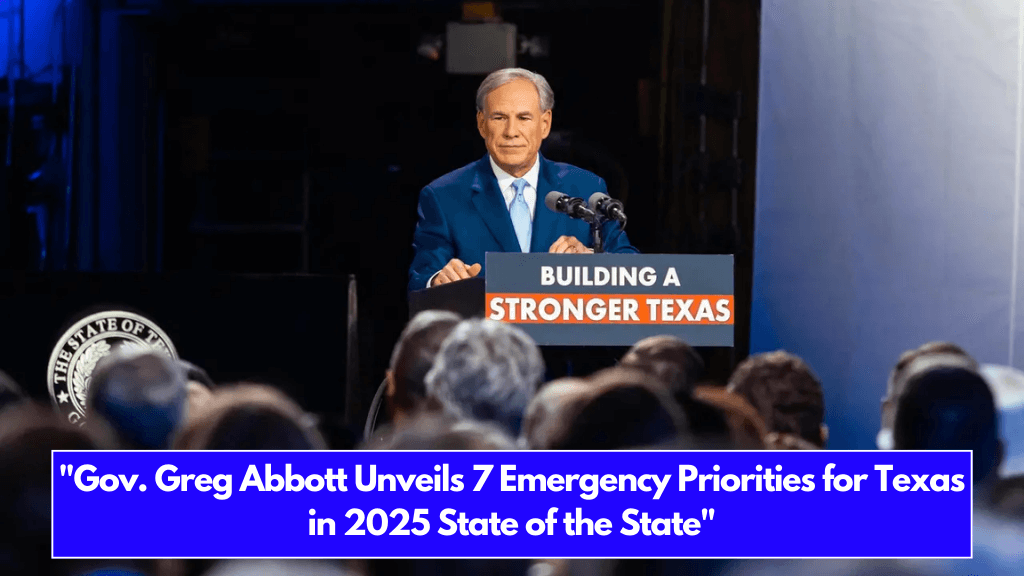On Sunday, Feb. 2, 2025, Texas Governor Greg Abbott delivered his highly anticipated State of the State address, laying out his top priorities for the 89th session of the Texas Legislature.
From school choice programs to property tax relief and DEI bans, Abbott outlined a bold legislative agenda aimed at reshaping Texas policy in education, infrastructure, and public safety.
1. School Choice Declared an Emergency Item
One of the most prominent topics of Abbott’s address was school choice, which would allow families to use public tax dollars to send their children to private schools. Declaring it an emergency item, Abbott received a standing ovation from Republican legislators.
Why It’s Controversial:
- Rural Republicans have historically opposed the plan, arguing that vouchers primarily benefit families in urban areas with access to more private schools, while rural public schools suffer from reduced funding.
- Democrats have also resisted, citing concerns over public education funding cuts and inequality between wealthy and low-income families.
What’s Different This Session?
In the 2024 election cycle, Abbott successfully backed primary challenges against many GOP lawmakers who opposed his school choice agenda. He now believes he has enough Republican votes to pass the legislation this session.
Budget proposals from both the House and Senate include funding for the school voucher plan, and Lt. Gov. Dan Patrick confirmed that the Senate is set to pass its version soon.
2. Property Tax Relief: No New Taxes Without Voter Approval
Another key issue was property tax relief, with Abbott proposing a law that bans local governments from raising property taxes without two-thirds of voter approval. His slogan, “No approval, no new taxes,” resonated with Republican lawmakers who have long prioritized tax cuts.
Abbott has proposed $10 billion in property tax relief, marking it as another of his seven emergency items for the session.
3. Seven Emergency Items for the 89th Legislature
Abbott’s full list of emergency items includes:
- $10 billion in property tax relief
- Investments in water infrastructure to address Texas’ growing water demands
- Increased teacher pay to address educator shortages
- Career training programs in high schools to better prepare students for the workforce
- Education savings accounts (part of the school choice plan)
- Bail reform to keep dangerous offenders behind bars
- Creating Texas Cyber Command to protect the state from cyberattacks
4. Banning Diversity, Equity, and Inclusion (DEI) Programs
Abbott also pushed for the expansion of bans on DEI programs, which he labeled as divisive and harmful.
Proposals Include:
- Banning DEI in grades K-12
- Expanding the existing ban on DEI programs at public colleges and universities
- Barring DEI practices from any entity that receives taxpayer funds
Abbott has joined a growing number of conservative leaders across the country in taking a stand against DEI initiatives, which they argue promote division over merit-based achievement.
5. Death Penalty for the Murder of Children
Abbott called for imposing the death penalty on anyone convicted of murdering a child, highlighting the tragic case of 12-year-old Jocelyn Nungary, who was killed in Houston by gang members in the country illegally. Jocelyn’s mother was present at the address, making this moment one of the most emotional of the evening.
Abbott’s push for this legislation reflects his focus on public safety and tough-on-crime policies.
6. Investing in Water Infrastructure
Abbott emphasized the need for major investments in water infrastructure as Texas faces increasing demands due to its booming population and growing economy. Ensuring adequate water resources is seen as critical to the state’s future economic growth and sustainability.
7. Teacher Pay and Career Training Programs
To address ongoing teacher shortages, Abbott proposed increasing teacher pay and expanding career training programs in high schools to better prepare students for jobs in high-demand industries such as technology, healthcare, and manufacturing.
These measures aim to strengthen Texas’ workforce pipeline and ensure students graduate with practical skills.
